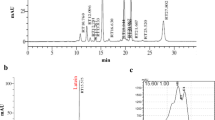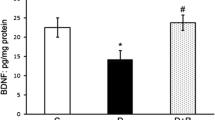Abstract
Diabetic retinopathy (DR) is a serious neurodegenerative disease that is induced by hyperglycaemia. Oxidative stress, inflammation and endoplasmic reticulum (ER) stress are involved in the development of DR. Sulforaphane (SF) is widely found in cruciferous plants and has a protective effect against retinal neurodegeneration in diabetes, but the mechanism is unclear. In this study, we investigated the mechanism by which SF protects against photoreceptor degeneration in diabetes. In vivo, a mouse model of diabetes was established by streptozotocin (STZ) injection, and the mice were treated with/without SF. Electroretinography (ERG) and H&E staining were used to evaluate retinal function and morphology. In vitro, 661w cells were treated with AGEs with/without SF. Cell viability and apoptosis were analysed by CCK-8 assay and flow cytometry. The expression of proteins and genes was assessed by western blot and qRT-PCR. The amplitude of the a-wave was decreased and the morphology was changed in the diabetic mice, and these changes were delayed by SF treatment. The percentage of apoptotic cells was increased and the cell viability was decreased after the treatment of 661w cells with AGEs. Moreover, the expression of GRP78, Txnip and TNFα was increased, however, this increased expression was reversed by SF treatment via AMPK pathway activation. Taken together, these data show that SF can delay photoreceptor degeneration in diabetes, and the underlying mechanism is related to the inhibition of ER stress, inflammation and Txnip expression through the activation of the AMPK pathway.







Similar content being viewed by others
References
Bogdanov P, Corraliza L, Villena JA, Carvalho AR, Garcia-Arumí J, Ramos D et al (2014) The db/db mouse: a useful model for the study of diabetic retinal neurodegeneration. PLoS One 9(5):e97302
Cui C, Li Y, Liu Y (2019) Down-regulation of miR-377 suppresses high glucose and hypoxia-induced angiogenesis and inflammation in human retinal endothelial cells by direct up-regulation of target gene SIRT1. Hum Cell 32(3):260–274
Dehdashtian E, Mehrzadi S, Yousefi B, Hosseinzadeh A, Reiter RJ, Safa M et al (2018) Diabetic retinopathy pathogenesis and the ameliorating effects of melatonin; involvement of autophagy, inflammation and oxidative stress. Life Sci 193:20–33
Fimognari C, Hrelia P (2007) Sulforaphane as a promising molecule for fighting cancer. Mutat Res 635(2–3):90–104
Hammes HP, Alt A, Niwa T, Clausen JT, Bretzel RG, Brownlee M, Schleicher ED (1999) Differential accumulation of advanced glycation end products in the course of diabetic retinopathy. Diabetologia 42(6):728–736
Hernández C, Dal Monte M, Simó R, Casini G (2016) Neuroprotection as a therapeutic target for diabetic retinopathy. J Diabetes Res 2016:9508541
Kim CS, Kim J, Kim YS, Jo K, Lee YM, Jung DH et al (2019) Improvement in diabetic retinopathy through protection against retinal apoptosis in spontaneously diabetic torii rats mediated by ethanol extract of Osteomeles schwerinae C.K. Schneid. Nutrients 11(3):546. https://doi.org/10.3390/nu11030546
Lai DW, Lin KH, Sheu WH, Lee MR, Chen CY, Lee WJ et al (2017) TPL2 (therapeutic targeting tumor progression locus-2)/ATF4 (activating transcription factor-4)/SDF1α (chemokine stromal cell-derived factor-α) axis suppresses diabetic retinopathy. Circ Res 121(6):e37–e52
Li S, Yang H, Chen X (2019) Protective effects of sulforaphane on diabetic retinopathy: activation of the Nrf2 pathway and inhibition of NLRP3 inflammasome formation. Exp Anim 68(2):221–231
Lionetti MC, Mutti F, Soldati E, Fumagalli MR, Cocce V, Colombo G et al (2019) Sulforaphane cannot protect human fibroblasts from repeated, short and sublethal treatments with hydrogen peroxide. Int J Environ Res Public Health 16(4)
Maeda S, Matsui T, Ojima A, Takeuchi M, Yamagishi S (2014) Sulforaphane inhibits advanced glycation end product-induced pericyte damage by reducing expression of receptor for advanced glycation end products. Nutr Res 34(9):807–813
Rajaraman B, Ramadas N, Krishnasamy S, Ravi V, Pathak A, Devasena CS et al (2019) Hyperglycaemia cause vascular inflammation through advanced glycation end products/early growth response-1 axis in gestational diabetes mellitus. Mol Cell Biochem 456(1–2):179–190
Ren X, Wang NN, Qi H, Qiu YY, Zhang CH, Brown E et al (2018) Up-regulation thioredoxin inhibits advanced glycation end products-induced neurodegeneration. Cell Physiol Biochem 50(5):1673–1686
Shruthi K, Reddy SS, Reddy GB (2017) Ubiquitin-proteasome system and ER stress in the retina of diabetic rats. Arch Biochem Biophys 627:10–20
Simó R, Hernández C, European Consortium for the Early Treatment of Diabetic Retinopathy (EUROCONDOR) (2014) Neurodegeneration in the diabetic eye: new insights and therapeutic perspectives. Trends Endocrinol Metab 25(1):23–33
Subedi L, Lee JH, Yumnam S, Ji E, Kim SY (2019) Anti-inflammatory effect of sulforaphane on LPS-activated microglia potentially through JNK/AP-1/NF-kappaB inhibition and Nrf2/HO-1 activation. Cells 8(2)
Tarozzi A, Angeloni C, Malaguti M, Morroni F, Hrelia S, Hrelia P (2013) Sulforaphane as a potential protective phytochemical against neurodegenerative diseases. Oxidative Med Cell Longev 2013:415078
Tonnies T, Stahl-Pehe A, Baechle C, Castillo K, Yossa R, Holl RW, Rosenbauer J (2019) Diabetic nephropathy and quality of life among youths with long-duration type 1 diabetes: a population-based cross-sectional study. Pediatr Diabetes 20(5):613–621
Uruska A, Gandecka A, Araszkiewicz A, Zozulinska-Ziolkiewicz D (2019) Accumulation of advanced glycation end products in the skin is accelerated in relation to insulin resistance in people with type 1 diabetes mellitus. Diabet Med 36(5):620–625
Weisová P, Dávila D, Tuffy LP, Ward MW, Concannon CG, Prehn JH (2011) Role of 5′-adenosine monophosphate-activated protein kinase in cell survival and death responses in neurons. Antioxid Redox Signal 14(10):1863–1876
Xiang M, Tang J, Zou XL, Zhao ZY, Wang YY, Xie SN (2009) Beta cell protecting and immunomodulatory activities of Paecilomyces Hepiali Chen mycelium in STZ induced T1DM mice. Am J Chin Med 37(2):361–372
Xu J, Chen LJ, Yu J, Wang HJ, Zhang F, Liu Q, Wu J (2018) Involvement of advanced glycation end products in the pathogenesis of diabetic retinopathy. Cell Physiol Biochem 48(2):705–717
Funding
This project has been supported by Grant No. 31371218 from the National Natural Science Foundation of China and Grant No. LQ2017005 from the Basic Scientific Research Projects of Liaoning Provincial Education Department. This project was also supported by Liaoning Provincial Program for Top Discipline of Basic Medical Sciences and National and Local Joint Engineering Research Center for Mongolian Medicine Research and Development (MDK2019041). This project was also supported by Grant NO. 2020-BS-189 from the Natural Science Foundation of Liaoning Province.
Author information
Authors and Affiliations
Contributions
Xiang Ren and Li Kong conceived and designed the experiments. Jinjuan Lv and Shuyin Bao performed the experiments and analysed the data. Tianhe Liu Limin Wei, Dongming Wang, Weikang Ye, Shiyu Song, Nina Wang, Jiao Li and Maryam Chudhary contributed some experiments, reagents, materials and analytical tools. Jinjuan Lv wrote the manuscript.
Corresponding authors
Ethics declarations
Conflict of interest
The authors declare that they have no conflict of interest.
Ethical approval
All protocols and use of laboratory animals were approved by the Animal Care Committee of Dalian Medical University Laboratory Animal Center.
Additional information
Publisher’s note
Springer Nature remains neutral with regard to jurisdictional claims in published maps and institutional affiliations.
Rights and permissions
About this article
Cite this article
Lv, J., Bao, S., Liu, T. et al. Sulforaphane delays diabetes-induced retinal photoreceptor cell degeneration. Cell Tissue Res 382, 477–486 (2020). https://doi.org/10.1007/s00441-020-03267-w
Received:
Accepted:
Published:
Issue Date:
DOI: https://doi.org/10.1007/s00441-020-03267-w




